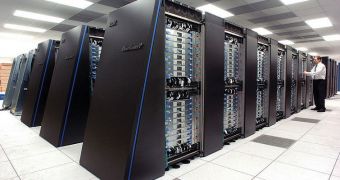Officials at the US Department of Energy (DOE) announce that the Argonne National Laboratory (ANL) will host a number of scientific projects this year, which will all use the facility's world-class supercomputer. Five ANL experts will be leading the project, which together won more than 200 million processor-hours on the Intrepid IBM Blue GENE/P supercomputer. The machine is capable of performing 557 trillion calculations per second, its managers say.
“By providing millions of hours of computing time on this powerful system, these awards allow us to address some of the nation's most challenging scientific problems,” explains the directors of the Argonne Leadership Computer Facility (ALCF), Pete Beckman. He adds that the IBM machine contains more than 160,000 processors, whose performance is increased by the over 80 terabytes of memory made available to the researchers. The role of the five ANL experts will be to assist researchers conducting their investigations here in optimizing and scaling their applications to maximize the use of these powerful resources.
One of the projects that will run at the ALCF will be conducted by the US National Oceanic and Atmospheric Administration (NOAA), and will deal with running ultra-high-resolution global climate simulations. Investigators at the Stanford University will carry out very-large-scale turbulence simulations, in collaboration with ANL colleagues. But there projects must give priority to the five selected under the Leadership Computing Challenge (ALCC), by a rigorous peer-review process. Here are the five research initiatives:
Andrew Siegel, the leader of the ANL nuclear simulation activities, was awarded 75 million processor-hours for analyzing the turbulent flows that develop in the cores of light-water reactors. ANL nuclear engineer Micheal Smith will contribute to the analysis and design of sodium-cooled fast reactors. His investigation was supported by the DOE through allowing him 38 million processor-hours on the Blue Gene/P supercomputer.
An additional 36 million hours were awarded to ANL Advanced Photon Source (APS) expert Michael Borland, who conducts his work in the field of optimizing the configuration of magnets. These elements will be used to upgrade the APS itself, but the scientist needs to conduct his work fast, so that the upgrade does not impact the usual scheduled at the Source. The fourth DOE grant goes to ANL senior computational biologist Benoit Roux, who received 28 million hours for developing methods of studying complex biological macromolecular systems.
The last grant goes to scientist Larry Curtiss, who is based at the ANL Center for Nanoscale Materials. He will use 20 million processor-hours for searching for materials that may innovate the way we use energy. Battery technology will represent an important focus.

 14 DAY TRIAL //
14 DAY TRIAL //